A few housekeeping notes following up on the previous entry.
First, I forgot (or maybe never realized) that you can temporarily freeze the SA-X to give yourself a moment’s respite during the big chase scene. This doesn’t do that much to help, but some help is better than none whatsoever in such a deadly sequence. As reader “Dark Holy Elf” (presumably an alias) notes in the comments, the SA-X once again demonstrates its fearsomeness if you do try to freeze it; while you can stop it in its tracks, it immediately enters the flashing state that indicates an enemy is about to defrost. The freeze state lasts about two seconds for SA-X. Even hitting the thing’s weakness doesn’t do you much good.
Also, the platforming and weapon puzzles you have to deal with in order to acquire new power-ups are growing increasingly arcane and tricky. The only way to get this Power Bomb is to freeze these Rippers side by side beneath the low overhang, creating an ersatz platform that you can roll across and then leap from.
Anyway, per usual, Adam sends you after your next objective; this time it involves destroying a beast instead of seeking an item. He goes into great detail about the damage this thing has wrought…
…although, once again, his commentary proves superfluous. The revamped graphic set for Sector 5 makes Nightmare’s power quite clear. The glass panes separating the foreground from the back of the sector are now cracked or shattered, portions of flooring have rippled and disintegrated, and certain structural elements have collapsed.
I find a frustrating irony in the fact that the Metroid game that offers the most elaborate and intentional narrative through level design — changing, evolving level design at that — is also the Metroid game that demonstrates the greatest compulsion to overexplain itself through text. We’ve seen fascinating hints of story in subtle details of previous Metroid adventures, such as the shattered Chozo statues near the Metroid Queen’s lair in Return of Samus and the entire prologue of Super Metroid. Fusion takes that principle to its most elaborate extreme… then smothers you with explanatory dialogues. Well, monologues, really. It’s like going to an art gallery opening and having the featured artist hover over your shoulder to explain every painting to you, in case you missed the symbolism he sweated over. It’s OK, creators! Have confidence in your work.
Much of this area has become flooded, and the X parasite shows off more of its adaptability: The X that mimic Space Pirates have gained the ability to transform into mer-forms, something decidedly lacking in the Space Pirates you encountered throughout Maridia.
Not unlike what Portal would do five years later, as you gain more “freedom” and increasingly are forced to find back routes to reach objectives that have become trapped behind ruined doorways and melted rooms, Samus spends more and more time “backstage” in the game. This isn’t breaking the fourth wall or anything, but you need to navigate service corridors and other passages clearly intended for the B.S.L station staff. Compared to the straightforward paths you traverse in the game’s first half, this really adds to the sensation that the game’s setting is rapidly spiraling into chaos.
This makes for a nice touch, too: Normally Metroid games have Samus show up after the fact. Here in Fusion, though, you watch the collapse unfold as you complete your mission. Samus is, essentially, patient zero for the X outbreak, caught up in the crisis she unwittingly prompted. Which isn’t to say she’s the bad guy here. She’s not the one who was cultivating bioweapons of mass destruction, after all.
As always, an infested eyeball door serves as your warning of the battle about to transpire.
But what’s this? Instead of a boss, it’s an Energy Tank?
Season Metroid vets should be wise to such unexpected generosity. You can’t trust the level designer.
Indeed, detonate a Power Bomb and you’ll reveal trick flooring that drops you permanently into the next chamber if you take the direct route, along with a passage in the ceiling that actually takes you to the Energy Tank. But you know, even if you’re not familiar with the fake floors next to too-convenient Energy Tanks of the older Metroids, Fusion has still given you ample warning for this ruse. Most of the game’s boss battles and the recent SA-X encounter saw Samus entering a seemingly innocuous room that dropped her into the thick of battle. And certainly there have been item-related fakeouts aplenty, such as the devious and hateful Mimics.
None of those encounters come close to matching the ruthless difficulty of Nightmare, though. This could well be the most difficult boss battle in the entirety of the series. The spider and infested Torizo were rough, and that SA-X escape sequence intense, but Nightmare involves multiple phases, disables your weapons, soaks up a ridiculous amount of damage, and flies around the room with a ponderous bulk that makes it seemingly impossible to evade. Nightmare comes by its name honestly.
Initially, the creature hovers around, altering its altitude and firing off a triple spread of energy beams from both its “arms.” While you need to pay attention to the timing of its firing sequence in order to predict whether you’ll need to jump or duck to evade the plasma beams, this isn’t too tough.
After its initial pass, however, Nightmare alters the playing field by activating a gravity generator that severely impairs Samus’ ability to jump. The gravity is also sufficient to make her Freeze Missiles essentially useless; they barely emerge from Samus’ arm cannon before plummeting to the ground harmlessly. It’s not impossible to hit Nightmare with a missile in this phase, but it’s dangerous and difficult — you have to be standing directly beneath its weak point (the circular gravity generator pod between its arms), which means you’re probably going to take a hit as it drifts through its pattern.
So, the fight begins by removing two key tools from Samus’ arsenal: Her mobility and her most powerful attack.
No, you’re much better off relying on the Charge Beam. It does less damage to Nightmare, and it obviously involves charging time, but you can hit Nightmare from a distance. The wide spread of the Charge Beam at this point (thanks to the acquisition of effects like Plasma Beam and Spazer) also means your shots are more likely to slip past the barrier created by Nightmare’s appendages. Given the power of the upgraded Freeze Missiles, it’s entirely possible you’ve forgotten all about the Charge Beam by this point in the game. Nightmare deliberate forces you to avoid relying entirely on the chain of power progression.
As Nightmare takes damage, its mask begins to ooze; once you destroy the gravity generator, the mask shatters, revealing a hideous decomposing creature inside. Now its only vulnerable point is its exposed face, which is not as easy to hit as it might look. You basically need to shoot it from directly across on a horizontal line. But at this point, the monster’s pattern changes and it begins to swoop around the room, aiming toward Samus, before settling in an homing in on her in a slow, direct line. Samus regains her mobility with the gravity generator gone, but Nightmare’s size, speed, and extended pattern make the thing incredibly difficult to dodge.
A handy ladder on the upper left wall serves as a handy perch for drawing a bead on the creature, though Nightmare does tend to drift somewhat off of a straight horizontal line, so you need to scramble to remain aligned with its weak point. You also can’t afford to stick around too long at this spot, because Nightmare will keep right on drifting until it plows right into you. It’s essential to know when to exercise the better part of valor and begin evasive maneuvers — especially since your movements determine Nightmare’s follow-up attack pattern, and if it settles in for its slow phase too high or too low you won’t be able to hit it easily and will essentially waste an entire precious iteration of the pattern. Given Nightmare’s size, mobility, and power, the longer you take to destroy it, the more likely you are to fumble the parts where you can only evade the beast. So this isn’t just a test of firepower; it’s about pattern recognition, alternate tactics, rate of fire, and balancing your attack actions with evasion.
Eventually, though, Nightmare will go down (you can tell, because its face turns red and melty) and reveal a relatively harmless Core-X. This one doesn’t have a protected core or firing capabilities like the last one did, because the game designers have some sense of mercy.
And, naturally, your reward for defeating this durable, gravity altering monstrosity is the Gravity Suit, which increases Samus’ durablity. Natch.
The end game is in sight.


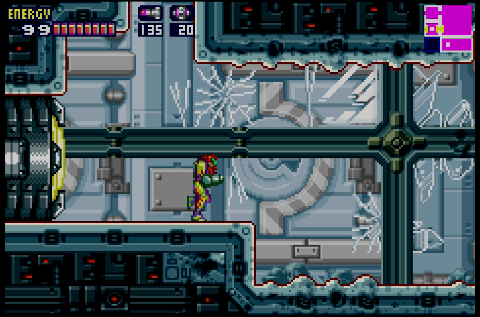
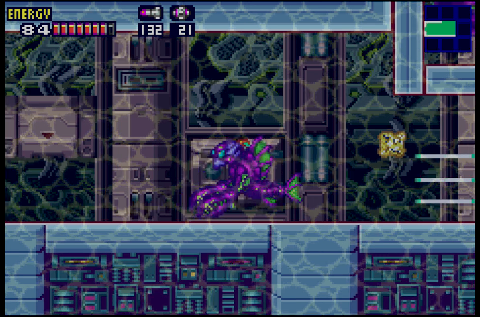
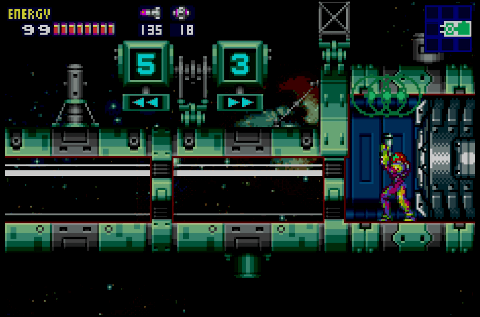

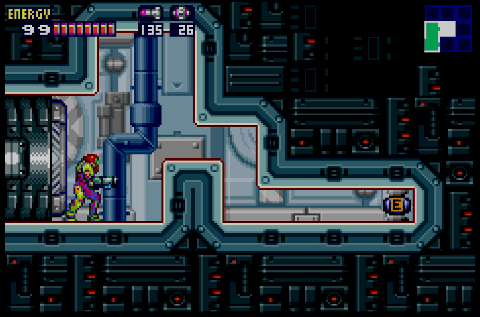
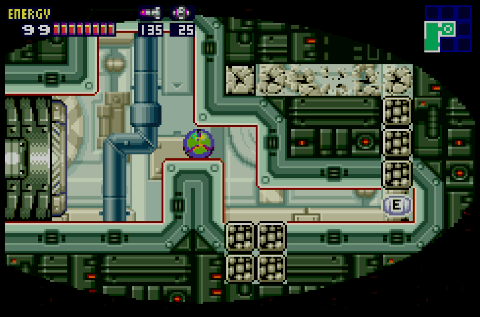
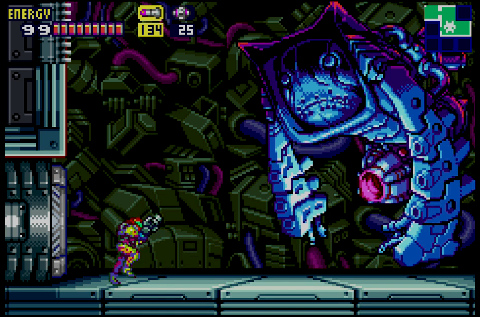


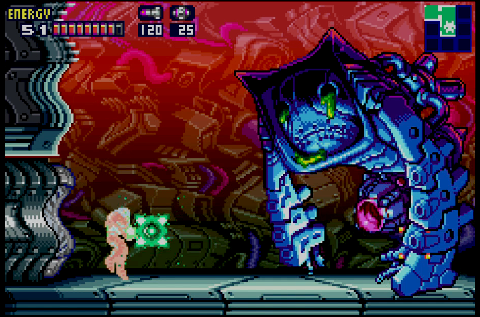

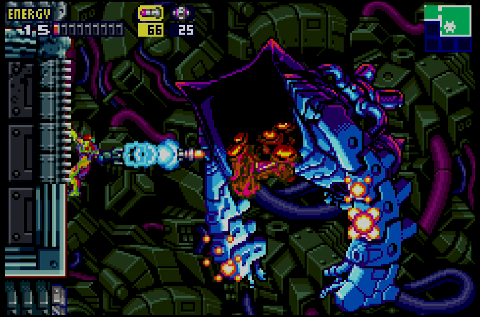

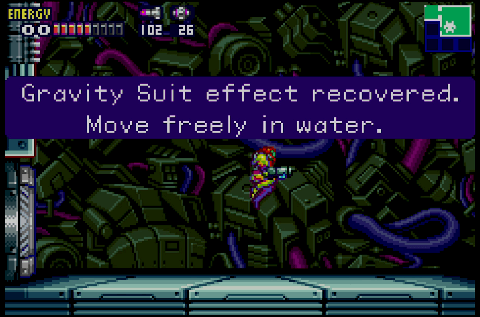
I have just noticed that at least the Docking Bay, the Yakuza and Nightmare rooms all have a different perspective projection than any other area. Given another later boss also has it, I suppose it is meant to give the “epic battle” visual cue. Perosnally, now that I cant unsee it, I find it quite jarring tbh.
I mentioned in an earlier post that the spider boss stopped my initial playthrough of this game back in the original GBA days, but I may have eventually beaten it - I have distinct, frustrating memories of Nightmare as well. The tiny GBA screen, plus bad lighting, plus sweaty hands made this one a literal nightmare.
Nowadays with better hardware I can really appreciate this boss battle. I would also nominate it as the most horrifying boss in any Metroid game - “Fusion” does tend to overexplain, but I don’t think any really thorough explanation is given for what EXACTLY Nightmare is, other than a powerful bio-weapon. What’s it really made of? Why is it rotting? Etc. Frightening stuff.
While Adam telling you things you can clearly see for yourself is indeed irritating, it does make a good amount of sense in-universe. As he serves as your C.O., it really is his job to warn you of any possible danger, and that includes things that are super simple and obvious.
Actually, most of the things that are there for no real reason and kinda waste time serve a point in the story itself, like finding the animals, as they were the only other survivors.
Yeah, an earlier update mulled that idea. I still want to punch Adam in his stupid robo-mouth, though.
I’m sorry, J. I’m afraid you can’t do that.
If anyone knows this it would be you, Jeremy, but does Nightmare have any kind of backstory? Or an explanation why it also shows up in Other M? I haven’t played through Fusion again since it first came out but the image of Nightmare always stuck with me.
In Fusion it’s just described as a bioweapon. That’s enough to make the point that the Federation and B.S.L. were up to shenanigans.
Back in the day, I had this whole fight memorized, which really underlines how much it was about pattern recognition. After a while I felt more threatened by the Core X! I don’t say that to brag though. I can’t even remember how many times I died trying to learn its patterns…